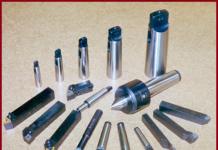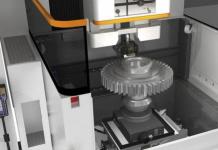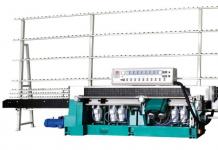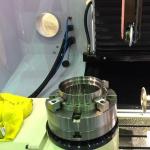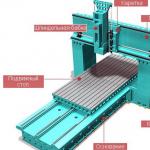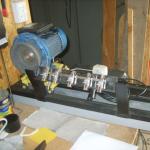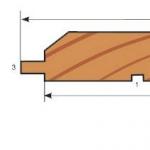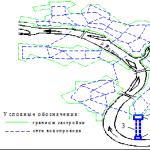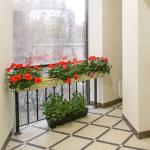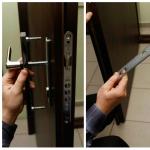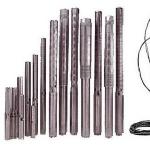Eurolining, block house, floorboards with grooved ends and similar molded wood products are popular and expensive materials, if there are available raw materials and a need for a large volume, it is advisable to consider purchasing special devices for making them yourself. Given the high requirements for geometric accuracy of such products and the difficulties in grooving, the best results are achieved with machines that process the workpiece in one pass, with the ability to adjust the spindles.
Equipment types
- The presence or absence of automated control.
- The number of spindles (varies from 4 to 8) and how they are controlled (manual or mechanized). The more clamping shafts, the more complex and precise the workpiece is.
- The type of bed (one-piece or prefabricated) and the material of its manufacture.
- Mobility of equipment for the production of lining. It functions after installation and secure fixing in a stationary state, but the weight and dimensions of some options allow them to be used as portable ones, others do not.
In general, when choosing, take into account:

1. Start 4×160.
The advantages include reliability, the ability to accurately and quickly adjust geometric dimensions, high productivity, the presence of stepless feed control, convenient access to all parts, tight pressing of materials with rollers and special base plates, good vibration damping, and much more. System settings are adjusted using a mobile remote control, Start 4×160 has a reliable protection that prevents the ejection of the workpiece or its displacement during processing. Dimensional deviation does not exceed 0.01 mm. All this, combined with an affordable price and a guarantee of 2 years, significantly increases competitiveness in comparison with foreign analogues. It is recommended to buy both for the manufacture of lining at home for their own needs, and for the production of products for sale.

It processes boards and timber from 900 mm long, from 20 to 200 mm wide and 11-64 mm thick. The feed rate is adjustable in steps. Equipped with 2 cutters with straight blades and 2 sets of horizontal blades, combined in a single design that eliminates the effects of vibration. All individual nodes have protective housings, control is carried out directly, all buttons are located on the front panel.

This compact and multifunctional machine from a well-known Swedish manufacturer is recommended to buy if necessary for profiling and gouging blanks, its distinguishing feature is the ability to quickly change knives, separate adjustment of the motors of each spindle and high-quality wood processing, regardless of its hardness. With low power consumption (total power does not exceed 12.5 kW), it provides at least 500 running meters. eurolining in 1 hour, reliable thermal protection of engines excludes their overheating. The durability of resources is due to the correct fixing of the upper and lower shafts, thick steel of the bed (4 mm) and the presence of a stable cast-iron table.
This Russian device is characterized by high functionality; in terms of its performance, it is suitable for any woodworking enterprise with different output volumes. The quality and accuracy of manufactured products is ensured by the presence of a stepless system for feeding workpieces placed in a cylinder and equipped with a spring-loaded mechanism for adjusting pressure rollers, soft polyurethane rollers that pick up the product at the exit, and a groove cutter and ruler on the first spindle. The only disadvantage of LTT MB4013 is the limitation on the width of processed boards (130 mm), but this factor does not affect the production of eurolining, its profile does not exceed 12 cm.
The purchase of a professional machine for the manufacture of lining is considered justified only if you want to set up a permanent production of products for the purpose of selling them. A full-fledged line will become only if there is a convenient receiving table, a chamber for drying wood and equipment for sawing it.
When profiling a small volume on your own, a lamella or edge cutter is suitable; in the absence of experience, such batches are simply bought at the bases. An alternative option is do-it-yourself production, in which case the number of board passes increases several times, the quality of the products is inferior to those obtained on professional equipment, but this will be enough for your own needs.

A machine for making lining is necessary for anyone who wants, for example, to decorate a house or a change house with it.
Making a machine and producing lining yourself will cost several times cheaper than buying finished products in large volumes.
During construction and repair work, lining is indispensable, it is environmentally friendly, easy to process and attractive in appearance.
Of course, today manufacturers offer a huge range of such goods, but a lining made at home will always be of better quality and more reliable than the one you can buy.
In addition, having your own machine for the production of lining, you can eventually try to start a small business.
However, factory equipment is also expensive, although it pays off over time. There is a way out - to make it with your own hands, knowing all the subtleties of the process and understanding what material you have to work with.
How and from what is the lining made?
It is noteworthy that for the manufacture of lining, different types of wood are needed. For finishing work (both facade and interior), wood of the following species is chosen: pine, larch, cedar, spruce.
They choose lining from such material also because it has a specific, pleasant and resinous smell that fills the room with comfort. Specifically, for interior work, ash, linden, and aspen are used.

Such trees are less durable, but they are chosen for their attractive appearance and color spectrum.
If you are going to make lining with your own hands using a home machine, then you need to understand that it must meet many requirements and not be inferior to the one made using industrial technology.
The manufacture of lining is that the finished sheet must be perfectly even, without bumps, deformations, hooks. This is achieved by grinding.
Also, the lining should be impregnated with special solutions, sometimes it is varnished. This is necessary so that moisture does not have such a destructive effect on the wood.
If properly impregnated with wood, it will last for decades. Depending on the type of tree, different methods of cutting are chosen.
For example, if we are talking about pine, then only the lower part of the tree is sawn, because there are fewer knots.
Larch, on the other hand, is a cheap substitute for oak, it is distinguished by high strength and integrity of the fiber structure.
How to make a home machine?
The machine for the manufacture of lining must process the board from four sides at once, so its design is complex, especially if you do everything yourself.
An important parameter by which devices are characterized is the cross section of the material that is obtained at the output. The larger the cross section, the greater the power of the device should be.
First of all, they are engaged in assembling the frame of the machine - this includes a table and a frame. The work surface needs to be given a lot of attention.
Therefore, it is important to ensure high-quality welding of all parts, especially if welding will also be done by hand.
Most often, a home-made machine is made of durable sheet iron, because the table must be narrow, long and stable.
In the middle of the sheet, it is necessary to make a hole where special rollers will be installed. They are driven by an electric motor.
The dimensions of the sheet allow not only to make lining with a large cross section, but also to improve operational properties.
The fact is that the larger the home-made machine will be in mass, the less vibration will be during operation. Increased vibration always puts the high quality of the finished lining at risk.
The next at home is making a knife shaft. Perhaps it would be superfluous to say that the quality of the finished material depends on this component, because this is the main cutting part.
That is why it is better to buy a finished shaft in a store, it is almost impossible to make it yourself.
The fact is that professional parts are properly balanced, properly polished, which allows not only to get high-quality lining, but also not to worry about the safety of the master during work.
As for the drive, it is better to give preference to stepped models, thanks to which you can adjust the supply of material for processing.
After that, an electric motor is installed - this process is easy to carry out even with your own hands. The main thing is to decide on the power. For domestic purposes, parameters from 2 to 5 kW are enough.
If you take more power, then you can not achieve the desired accuracy of processing, and less power does not allow you to cut wood at all.
Here, even an old engine from other devices, such as a washing machine, can be a budget option.
The last to install are pressure rollers that fix the wooden blanks on the machine sheet.
Here you can also use rollers from an old washing machine or purchase such parts from factory manufacturers.
Selection of tools and other subtleties of the process
Making a machine with your own hands is only possible if you have a whole list of special tools.
These include:
- welding machine, even with low power;
- an electric drill, which has nozzles that can handle metals;
- Sander;
- metal processing machine;
- lathe.
Unfortunately, it is realistic to make a machine yourself only if you have experience working with factory equipment. Without any practice, it is trite unsafe.
The reliability of the design should not be in doubt, and the creation of the machine can be delayed even for months. An alternative would be to purchase a milling or woodworking machine.
On such a device, the creation of lining takes place in several stages, however, such an apparatus is several times cheaper than a professional machine for the manufacture of materials.
When working with cutting equipment, it is necessary to constantly monitor the serviceability of tools, sharpen them in time and check for chips, irregularities.
Any roughness can cause part of the wood to ricochet, which often causes serious injury.
All blades and shafts must be properly secured by selecting heavy duty bolts and fully tightening them.
If you decide that it will not work to make a machine for lining at home, then you need to pay special attention to the choice of equipment. Check out all technical specifications.
Here it is worth starting from the load that will be assigned to the structure.
It is of great importance how often the machine will be used, whether it is needed for industrial production or the lining is made only for personal construction.
If you need to constantly produce lining, then it is better to take a powerful machine that operates at high speeds with a power of more than 5 kW. There are also manual and automatic models.
For the manufacture of lining in small volumes, a manual machine is enough, for business you need an automatic one.
The BELMASH brand is its own vision of woodworking equipment. The most significant share of the brand's products is household multifunctional woodworking machines and accessories for them.
Production
Woodworking equipment of the BELMASH trademark is produced by JLLC "Zavod Belmash" - a modern full-cycle production. The production complex is located in the city of Mogilev, Republic of Belarus. The staff of the enterprise is a team of highly qualified specialists. The level of technical equipment and qualifications of the staff allows us to perform work of a high degree of complexity.
Products
Our assortment includes woodworking machines and accessories for them, with which you can implement ideas in home improvement. They will become part of your workshop and your life. Our products are based on the unique developments of the design bureau. Reliability, thoughtfulness, safety - this is what distinguishes Belmash products in the first place.
The assortment policy takes into account the requirements of the market, so the new items have no direct analogues. Innovation and control in manufacturing give confidence in the quality of the product.
Simplicity, convenience and the middle price segment position Belmash household woodworking machines as the best choice for a home craftsman.
Prevalence
The central office of the company is located in Moscow. There are representative offices in Samara, Yekaterinburg, Krasnoyarsk, Novosibirsk. The geography of our sales extends to the territory of the Russian Federation, Kazakhstan, Armenia, Kyrgyzstan.
Mission
We strive to ensure that everyone can buy woodworking machines and additional equipment for them in the best way, as well as receive information support and quality service. Employees of the company are united by one goal - to make your purchase convenient and pleasant, and technical assistance - high-quality and timely.
The use of natural floorboards not only creates comfort in the room, but also creates a cleaner, more ecological atmosphere. Unlike parquet boards, flooring is made from solid wooden beams.
How to choose the right floorboard? Expert opinion on video.
Performance characteristics
This product differs from other types of coatings in its cumulative properties. Its main characteristics:
- reliability and durability (withstands load for a long period);
- durable material (characteristics do not deteriorate for a long time, depends on the material of manufacture);
- relatively high rates of thermal conductivity and sound insulation;
- resistance to deformation;
- environmental friendliness of the material.
Production
A modern floorboard begins with the selection of a suitable blank. After that, the material is subjected to longitudinal sawing. Milling work with wooden blanks and logs of large diameters is also allowed.
Next, floorboard machines are used to cross-cut and machine to achieve the dimensional characteristics of the workpieces. After that, the material is sent to the spreader.
Having left this zone, wooden blanks enter the sorting zone and are partially taken to the sawmill for sawing into half-beams, slabs and unedged material. The half-beam continues to move along the technological chain to the machine for the manufacture of boards, which converts the material into such products:
- rail;
- timber;
- board;
The resulting materials are packaged and sent for drying. B relieves internal stress by reducing moisture between the fibers. This allows the wooden product not to deform during long-term operation in dry, warm rooms. 
Processing and preparation for installation
- The dried workpiece is sent for processing from all four sides to a special planer for the floorboard. With it, the front side is also processed in a final form.
- After that, a tongue-and-groove connection is milled from the side ends, which helps to quickly mount the product in the premises.
- Thermogrooves are milled on the back side, which improve ventilation under the wooden floor.
There are various options for finishing the floorboard. Such boards do not need additional scraping. With proper care and finishing, such a floor will last for decades.
The floor has fallen into disrepair and urgently needs to be repaired. What material to choose for finishing, so that it is pleasant to walk barefoot and the coating looks neat, fresh and comfortable? An excellent solution would be to use natural natural material - wood. Modern technologies make it possible to make a durable and attractive do-it-yourself tongue-and-groove floorboard from ordinary wood.
What is grooved board
The classic edged board has been used for flooring for many centuries. The result is a warm and even floor, but such a coating has disadvantages that reduce comfort:
- annoying creaking of the floorboards, which can be very difficult to get rid of;
- gaps between the boards through which moisture and cold air pass;
- splinters and bumps dangerous for the skin;
- protruding nail heads.
A tongue-and-groove board is an edged floor board with side surfaces machined to look like a tongue for better laying.
Today, a solid wood floor is devoid of unpleasant disadvantages, although traditional varieties of hardwood, oak and coniferous species are used to create it:
- larch perfectly withstands mechanical stress, it is resistant to abrasion and does not rot at high humidity levels. Such a floor can be used outdoors for the construction of terraces and verandas, it is not required to varnish, if desired, you can use a colorless or tinted oil for care;
- oak has a dense and hard wood, the oak floor will last a long time and will not be scratched by chairs or heels;
- pine and spruce are soft, pleasant to the touch, but require varnishing.
There is also a board made of birch, alder, ash, mahogany, teak, and other valuable and exotic wood species.
Why is it needed and where is it used?
This natural material is used in construction for laying the finishing floor and subfloor in private houses and apartments, on balconies and loggias, verandas and terraces, saunas and public spaces.
For industrial and commercial premises with a large number of people and equipment, the need for frequent wet cleaning and constant mechanical stress, the use of wooden floorboards is not recommended.
Alder and aspen, according to the current GOST 8242, can be used for flooring only in living rooms. From cheap boards of grade C, they usually make rough floors.
You will learn more about what a massive board is, what types and varieties are there, the advantages and disadvantages of the material, as well as the difference from other types of coating, in the article:.
How it works
The tongue-and-groove board has its own design features, thanks to which it acquires improved technical characteristics for creating a high-quality finished floor:
The dimensions of such boards are given to several standard dimensions for ease of calculating material consumption and ease of installation. The length of the board is usually chosen equal to the length of the room. It is possible to manufacture longer or thicker slats for individual orders.
Standard sizes:
- length varies from 100 to 400 cm;
- width reaches from 8.5 to 10 cm;
- thickness is from 2.5 to 3.5 cm.
Advantages and disadvantages of the material
The tongue-and-groove floorboard improved with the help of modern technologies has a lot of advantages over a conventional edged one:
- the locking connection gives an even distribution of the load, a snug fit and the absence of gaps between the boards, higher thermal insulation and sound absorption. The floor looks like a single seamless canvas, it does not need to be scraped;
- The service life of a sheet pile is several decades. Repair will have time to get bored, but it will still look great. In this case, you can sand the surface and give it a different tone with a stain or colored varnish;
- Standard dimensions make it easy to replace a single plank or combine different types of wood into an original ensemble;
- the smooth front side of the material looks luxurious immediately after purchase, it does not require additional polishing, it can be varnished or protective compounds without the risk of raising the pile, it is pleasant and safe to walk on it barefoot;
- the absolute environmental safety of this natural material and the glue-free connection make it possible to use it in children's rooms and bedrooms. The antistatic effect does not attract dust to the floor surface and facilitates maintenance;
- due to the presence of tongues and grooves on the back of the product, the floor is more resistant to moisture, does not warp, does not dry out, does not creak. Bottom ventilation prevents the development of fungus and mold;
- ease of installation allows even a novice specialist, which significantly reduces the cost of repairs;
- The variety of wood types, processing methods and various decorative effects provides ample opportunities for decorating the interior and giving the house a unique style.
A smooth and beautiful wooden floor must be supplemented with a plinth to get a finished look of the room. You can read about how to attach the baseboard to the floor in the material:.
The grooved board has disadvantages, like any natural material:
- low resistance to water, with constant wetting, the material can swell and rot. To solve this problem, wood is impregnated with antiseptics, and also covered with protective oils, waxes, varnishes;
- the high cost of the material is due to its naturalness, the quality of the feedstock and the complexity of the processing technology;
- the fire hazard is reduced by impregnation with flame retardants that prevent the wood from igniting.
How to make a grooved board with your own hands
Another important advantage of tongue and groove is the possibility of making it yourself with certain woodworking skills. This painstaking work requires free time and knowledge of the intricacies of technology, as well as the rules for choosing high-quality raw materials. According to the appearance and condition of the material, the board is divided into the following grades:
- extra - the most expensive variety, there are no knots and defects on its surface, it has an absolutely smooth, uniform structure;
- A - a high-class variety, but small spots and darkening are allowed on its surface without the presence of knots or other defects in the wood structure;
- B - the most popular variety of the middle price category. Knots and other inclusions and spots on its surface do not spoil the general appearance, but create an additional decorative effect of naturalness;
- C is a cheap grade with acceptable various heterogeneities of the structure and through knots.
Having decided on the grade, you should pay attention to other criteria for choosing the source lumber:
- humidity should be 10-15%, and ideally up to 8%, such indicators are achieved using industrial drying in special chambers, after which the board acquires its stable size and will not dry out anymore. High-quality drying can be determined by a shiny surface and a ringing sound when tapped, and a high level of humidity is determined by the presence of condensate on the inside of the plastic packaging;
- the integrity of the package will allow you to maintain a low level of humidity and the quality of raw materials, when buying, you should also check the availability of certificates, checks and other accompanying documentation, it is recommended to choose products of well-known large brands that have earned the trust of consumers, a cheap board from an unknown manufacturer may be of poor quality;
- violations of the geometry and smoothness of grinding, especially for high-end products, are unacceptable, they will complicate the installation and may spoil the appearance of the finished coating. These parameters are checked visually and manually;
- when combining several different types of wood, boards of the same standard size should be selected to reduce the number of trimmings. The type of wood depends on the purpose of the premises and the planned loads, operating conditions.
Necessary materials and tools
Boards bought, now you can start work.
At large factories, grooving is carried out on high-precision machine tools with program control.
For home rabbeting, you will need the following tools and materials:
- tape measure, level, ruler, square, marking pencil;
- impregnation from fire and biological damage;
- jigsaw or hacksaw for size correction;
- jointer with quarter selection function, milling machine;
- clamps for fixing the workpiece.
In cases where solid floorboards cannot be used, engineered flooring may be a good option. What is an engineering board and how to mount it, we will tell you on our website:.
Step by step manufacturing process
Of course, it will not work to achieve a production class of extra grade boards in a home workshop, but it is quite possible to make a lock connection and subsequently get a beautiful, even floor without creaks and cracks.
Stages of work to be performed:
- Before work, you should keep the purchased raw materials indoors for several hours to adapt to temperature and humidity. A dry, clean board ready for processing must be fixed on the desktop with clamps so that it does not stagger or move during work.
- Measure the middle of the end side surface along the long side and mark for the lock connection.
- With a manual jointer or on a milling machine, you need to very accurately and accurately cut a quarter groove in one long end of the board.
- On the other end, you need to select quarters along the edges from the drawn axis to make a tongue.
- On the back side of the board, cut gutters or grooves for ventilation, one groove is enough. Sand the front side if necessary.
- Treat the finished planks with an antiseptic and fire impregnation, which will extend the life of the floor and delay the need for repairs.
Video: how to make a tongue and groove board with your own hands
A grooved board will last for decades if the material is chosen correctly and the grooves are done slowly and carefully. After laying, it is advisable to cover the floors with several layers of protective varnish, then they can be washed, heavy furniture can be moved and walked on stilettos without the risk of scratching or pushing through. Hardwoods that are resistant to mechanical stress can be coated with a special oil that will emphasize the beauty and reveal the texture of the wood.
Wooden building materials do not lose their popularity among consumers over the years. And such a sought-after area is the best suited for organizing your own business. And in order not to invest in a large investment, you need to choose a product that is easy to manufacture. This will become possible if you buy a machine for the production of lining.
Clapboard - a small thickness sheathing wooden board, actively used for external and internal finishing work.
Our business valuation:
Starting investments - from 800,000 rubles.
Market saturation is average.
The complexity of starting a business is 7/10.
A business in the production of lining, with a competent approach, will bring the entrepreneur high incomes. If you make a clear business plan and follow it further, you can build a stable business. And its main advantages are as follows:
- Relatively low costs for the purchase of equipment.
- Opportunity to start a business right in your garage.
- Availability of raw materials.
- High consumer demand.
The main drawback is the seasonal nature of the business - the sale of lining will be carried out for the most part in the spring and summer, since many consumers are now starting to engage in construction and repair.
When will the manufacture of lining be profitable?
No matter how promising this niche is, opening an enterprise for the production of lining will not always be a good idea. And in order to organize a profitable business, it is necessary to take into account many nuances:
- The cost of raw materials in a particular region should be low in order to be able to offer consumers inexpensive products.
- When starting the production of lining at home, you will need to thoroughly study the issue. And it would be nice if the entrepreneur already had certain skills in woodworking.
- When compiling a business plan for the production of lining, it is necessary to analyze the level of competition. If there are already many woodworking shops in a particular region, then the next enterprise will not “survive” here.
Has the analysis of the market niche shown that the business will become profitable? Then you can safely proceed to the implementation of the project.
Varieties of lining and raw materials used
There are 2 types of lining on the market - plastic and wooden. The first option has recently been gaining more and more popularity, since it is cheaper and more versatile in use. But despite such an excellent alternative to natural material, the production of wooden lining does not lose its relevance and will bring a high income to the entrepreneur.
Natural material attracts consumers with high quality and long service life.
Lining can be made from different types of trees:
- Coniferous (cedar, spruce, pine). Such material has a fragrant aroma, due to which it has become widespread in the construction of baths and saunas.
- Deciduous (ash, aspen, linden). The production of lining from linden and other hardwoods makes it possible to obtain material of different colors and textures at the output, which allows it to be used in completely different directions.
To supply only quality products to the market, you will need to find reliable suppliers of raw materials. And the wood entering the workshop must undergo strict quality control.
What technology is used to obtain lining?
The production technology of lining is not difficult, especially for those who are familiar with woodworking. The process is like this:
- Raw material quality control and sorting.
- Drying wood.
- Planing the front side of the board.
- Folding and grooving of products.
- Rejection of poor quality products.
- Packaging of finished lining by class.
The finished material must comply with the established standards - GOST 8242-88. But many enterprises today work according to their own specifications, which makes it much more difficult for consumers to choose.
The standard lining production line makes it possible to benefit from products of classes A, B and C. The distribution of products is carried out on the basis of whether there are any defects, knots or mechanical damage in the lining. But no matter what class the lining is assigned, it should not contain wormholes and traces of fungus.
What equipment is used in the production process?

Four-sided machine for the production of lining Start 160
An important point in planning further activities is the equipment of the future workshop. the entrepreneur will have to buy woodworking machines for the production of lining, which will make it possible to obtain a high-quality product in a wide range.
What set of machines will be required to start production?
- Sawmill. Special machines will allow you to cut whole logs of wood that have arrived at the workshop. The conformity of the received material to quality standards will depend on the quality of the machines. Price - from 170,000 rubles.
- Drying chamber. Few manufacturers buy ready-to-use dryers - mostly they are ordered directly from the manufacturer in the required dimensions. Another great option is to purchase a used machine of suitable parameters. Price - from 250,000 rubles.
- The machine for receiving lining. There is a huge selection of equipment - from cheap machines to expensive automatic devices. The simplest option is a longitudinal milling electric machine. But this will definitely require a cutter for lining - a very dubious savings. Price - from 350,000 rubles.
Many entrepreneurs significantly save on equipping the workshop by refusing to purchase a sawmill. In this case, the businessman will have to purchase "semi-finished products" in the form of a raw board. And the advantage will be not only savings, but also a significant reduction in the time of production.
Having purchased all the necessary equipment and installed it in the workshop, you can begin the production of aspen lining.
Rules for the sale of finished products
The production of eurolining is a common business. And for sure this niche in any of the regions of Russia is already represented by several large issuing companies. A novice entrepreneur will have to make remarkable efforts to win a place in the market.
You can express yourself in the consumer market with the help of advertising. And the main advertising platforms that will promote the production of eurolining will be:
- Outdoor advertising.
- Advertisements in newspapers.
- Distribution of leaflets in hardware stores.
When developing a marketing policy, you can also use the Internet. But it’s not worth investing a lot of money here - the “return” will be small.
A home machine will not be able to provide quality products to many customers. Large batches of goods can only be obtained using a powerful automatic line. Therefore, when negotiating cooperation with one or another wholesale buyer, it is necessary to look at things realistically - will it be possible to fulfill orders?
The products that the sawmill for lining and the milling machine gives at the output can be offered:
- construction companies,
- construction shops and bases,
- private clients.
It will be difficult to find profitable clients, and therefore, this should be done at the first stages of drawing up a business plan.
Let's calculate the possible profit
It will be difficult to name the exact payback period for the workshop, since everything depends on the established prices for finished products and sales volumes.
In order to buy equipment for the production of lining according to the minimum list, to provide a raw material supply and to formalize the enterprise according to the law, it will take at least 800,000 rubles. And investments will begin to "work" when distribution channels are established.
A line of small capacity gives up to 350 m 2 of lining per shift at the output. And if you sell all manufactured products at a minimum price of 150 rubles / m 2, you can earn up to 1,500,000 rubles per month. And this is indicated by the cost of the material of the lower class. Higher quality products are much higher - up to 500 rubles / m 2. In this case, the price of a machine for the production of lining at home will pay off much faster.
As practice shows, it is quite possible for small workshops to reach a higher level. First, you will have to cooperate with retail and small wholesale consumers. But with the increase in the production base, it will be possible to think about expanding the enterprise.
